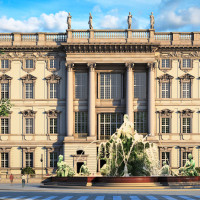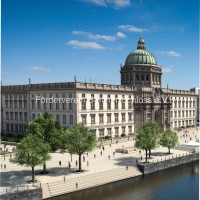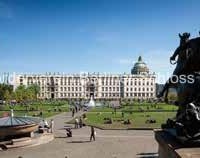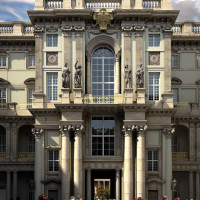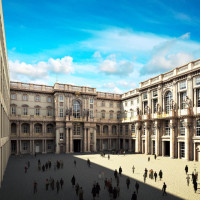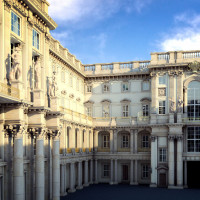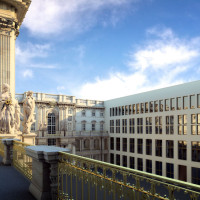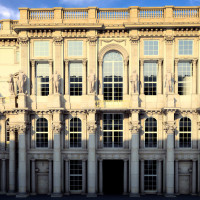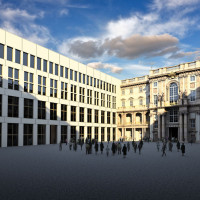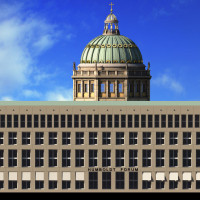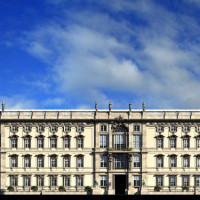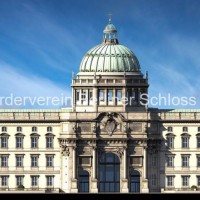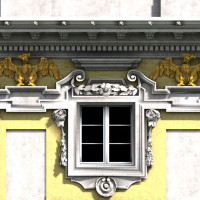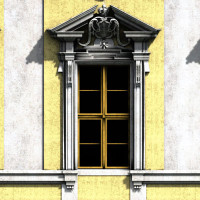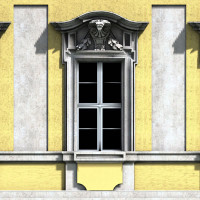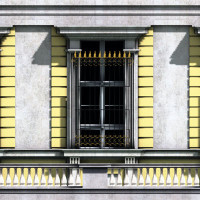The exterior
The New Berlin Palace is being reconstructed externally largely true to the original using traditional methods of craftsmanship. Its most famous component, the Schlüter Courtyard, is also being reconstructed.
The interior
On the inside, however, it is being designed in a largely modern style in keeping with its new use. Reconstruction of the main historic suites at a later date will, nevertheless, be possible, as the palace’s internal dimensions allow this to be done in situ. This thus makes further reconstruction an option for future generations.
Of its nearly 1,200 rooms these were fewer than 70. They made up around a third of the total space.
As the building was the seat of Prussia’s administration until well into the 19th century, the remaining rooms were civil servants’ small offices and rooms for services and logistics within the palace. Their size does not fit in with the requirements of the concept for the palace’s use today. Reconstructing them would therefore be nonsensical.
Spatial layout
The entire ground floor of the Humboldt Forum is being used for communication and international, cultural interaction. Provided for this are the rooms in the west wing of the palace, the Schlüter Courtyard and the historic vaulted basement. The ground floor is being split up with differing security standards into multiple requirement levels, including political debate, cultural performances, formal functions and changing exhibitions. It will also house the Site History Museum.
The first floor, covering a total of 5,000 m², will accommodate the Berlin’s great exhibition based on the theme of ‘World.City.Berlin’ and academic exhibitions put on by Humboldt University.
The Museums of Non-European Arts and Cultures will be housed on the second and third floors of the building. Some of the walls there will be movable in order to allow the museums to accommodate the latest requirements of exhibition didactics in the years to come.
CAD-Rekonstruktion: eldaco, Rostock
Basis of the plans
In its resolution the German parliament, the Bundestag, initially stipulated only that the palace exterior, i.e. the three Baroque façades and the Schlüter Courtyard, was to be reconstructed true its original form. Following the architectural competition in 2008, this have now been supplemented by the dome and the three historic inner portals around the former Great Palace Courtyard.
The Schlüter Courtyard is being built as it originally was, as an open courtyard. With its magnificent, formal Baroque façades and an area of around 4000 m², it is ideally suited for all kinds of large functions.
CAD-Rekonstruktion: eldaco, Rostock
The majority of the palace’s overall space used to consist of plain, little, insignificant rooms, as until well into the 19th century large parts of the Prussian administration were housed in the building. To reconstruct them would be a nonsense and not consistent with the new use. The palace is therefore going to be a modern building on the inside, while it historic façades will recreate the visual impression of the historic city.
The development of an architecture in which both approaches are harmoniously united in one holistic whole has been mastered in exemplary fashion by the winner of the architectural competition, Prof. Franco Stella from Italy.
The historic architecture of the palace is documented in such detail in remains, plans and photographs that it is possible to reconstruct it extremely accurately using methods of traditional craftsmanship. Impressive proof of this can now be seen, as the historic walls rise up on the construction site.
First of all, however, careful documentation of the historic palace had to be produced. The palace’s original building plans have been lost since as far back as the early 18th century.
Commissioned by the Friends of Berlin Palace and financially supported by the Ernst von Siemens Art Foundation, Berlin Technical University therefore developed in collaboration with Stuhlemmer Architects of Berlin a computer-aided photogrammetry programme based on all existing sources that made it possible to create exact building plans for the historic façades. To achieve this thousands of photographs were analysed, sharpened and dimensionally computed.
If you would like to get detailed information on this work:
link to Stuhlemmer Architekten Stuhlemmer Architekten
Full elevations
The most important criterion for us in the planning process was to reconstruct the palace exterior as accurately as possible. Surrounded by extremely valuable historic buildings, which all used the palace architecture as a reference point, we are now able to restore central Berlin’s grand ensemble, which the world’s art historians used to call the ‘Berlin complete work of art’.
All of the historic parts are being produced using traditional methods of craftsmanship. Modern techniques, such as 3-D scanners and robot technology, are indeed being used to do the majority of the sculpting work cost-efficiently by machine.
97% of the stone is, for example, being milled away by machine to expose the basic shape of the art work. However, the final 3% of the work is being done exclusively manually, so that the art work looks completely as if made by hand. Nobody sees the stone that has been hammered or milled away any more.
Due to the extraordinary individuality of the design of the individual parts of the façades (after all, between 1701 and 1716 hundreds of stonemasons and sculptures worked on them), moulded concrete or sandstone finished by machine were inherently out of the question. A palace reconstructed by machine with totally identical façade elements would, for example, ruin the wonderful, hand-crafted architecture of the Zeughaus and thus also the precious ensemble at the heart of Berlin.
The palace’s east façade is being given a modern look, in keeping with the future city centre to the east of the Spree.
Internal design
The synthesis of old on the outside and new on the inside of the new palace is an enormous challenge. However, Stella’s plans and the design studies for the room layout already let us sense what a great success it is going to be.
Historic rooms
The integration of reconstructed historic rooms is currently neither politically nor financially viable. However, the option for future generations to take this on was retained in the planning process.
Please follow the building’s progress here on the website. The best way to do that is via the webcam, although you can also do so via the issues of the Berliner Schloss Post, which can be read here electronically. Either way, you will then be right up to date!
The Press coverage section additionally informs you about everything that is going on at the political decision-making level and naturally also about the Humboldt Forum’s ongoing development.
Our website’s stunningly beautiful CAD reconstruction visuals have been altruistically produced at minimal cost out of love for Berlin Palace by Sandy Lunitz und Steffen Becker. They were then enhanced further by Sandy and using improved technology finished off in the perfection we see today.
We are extremely grateful to him for this and would be delighted if you would bear his company, eldaco of Berlin (tel.: 0049 /(0) 30 8639943), in mind for any relevant work that you may be ordering.
The variations in colour from picture to picture are down to the ‘sun’s altitude’ in the computer. A higher sun creates brighter colours in reality as well. All CAD images are copyright of Förderverein Berliner Schloss and eldaco, Berlin.
 Deutsch
Deutsch English
English





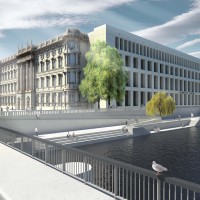



![091021_agora-mit-kuppel[1]](https://berliner-schloss.de/en/wp-content/uploads/sites/2/2015/02/091021_agora-mit-kuppel1-200x200.jpg)
